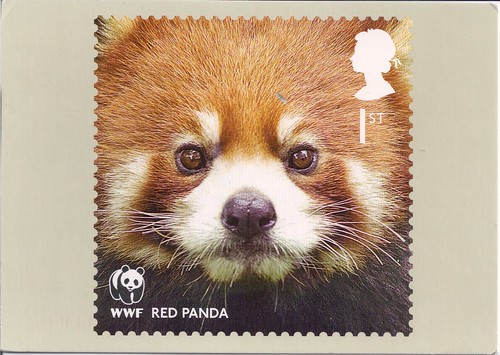|

I love Postal Issued Cards and am lucky that someone sent me this WWF Red Panda card from my Postcrossing Favorites.
Arrived from England.
Red Panda
From the temperate Himalayan forests of western Nepal to the high mountain slopes of southwestern China, the red panda (Ailurus fulgens), like the giant panda, is a mostly herbivorous mammal that feeds mainly on bamboo.
But that is where the similarities with its larger and more recognizable black and white distant cousin seem to end.
Red pandas look more like raccoons and are slightly larger than a domestic house cat (they even have feline-like whiskers), growing to about 50-63cm in length and weighing up to 6kg. They are skillful climbers that, when not foraging on the ground, spend most of their time in the trees curled up with their long, bushy tails wrapped around their heads. A thick reddish-brown fur offers additional protection from the cold, often harsh, mountain weather.
Under threat
The word panda comes from the Nepalese “poonya” which means bamboo eater. While the giant panda is sometime called the black and white cat-foot, the red panda is known as the red cat bear or lesser panda. While it may be “lesser” in size than the giant panda, both species are threatened by less habitat and deforestation.
An increase in human population, particularly in China and Nepal, has seen the red panda’s bamboo forest homes cut down and cleared for timber, fuel and agriculture land, pushing them to more remote, fragmented – and often unprotected – mountain areas.
Although protected internationally and in Nepal, the red panda remains highly endangered. While some pandas are found in Nepal’s Langtang National Park, Annapurna Conservation Area, Sagarmatha National Park, Manaslu Conservation Area, Makalu Barun National Park and Kangchenjunga Conservation Area, over 75% of potential red panda habitat falls outside protected areas.
Protecting the red panda and its fragile environment is vital to preserving the region’s natural heritage and global biodiversity.
Panda protection
Conservation work by WWF and its partners is currently underway in the Sacred Himalayan Landscape, which encompasses more than two-thirds of Nepal’s remaining red panda habitat.
For WWF and the government of Nepal, red panda conservation is a priority. Protecting the endangered species includes:
• Conducting in-depth field studies on red panda ecology, behaviour, habitat and distribution range to improve effective conservation
• Identifying potential red panda habitats suitable for protection
• Developing a broad-based awareness programme on red pandas to make local communities more aware about the importance of the species within the mountain ecosystem
The survival of the red panda and the protection of its habitat will ensure that people living in the region continue to reap ecosystem benefits for many generations.

England Stamps
Red pandas look more like raccoons and are slightly larger than a domestic house cat (they even have feline-like whiskers), growing to about 50-63cm in length and weighing up to 6kg. They are skillful climbers that, when not foraging on the ground, spend most of their time in the trees curled up with their long, bushy tails wrapped around their heads. A thick reddish-brown fur offers additional protection from the cold, often harsh, mountain weather.
Under threat
The word panda comes from the Nepalese “poonya” which means bamboo eater. While the giant panda is sometime called the black and white cat-foot, the red panda is known as the red cat bear or lesser panda. While it may be “lesser” in size than the giant panda, both species are threatened by less habitat and deforestation.
An increase in human population, particularly in China and Nepal, has seen the red panda’s bamboo forest homes cut down and cleared for timber, fuel and agriculture land, pushing them to more remote, fragmented – and often unprotected – mountain areas.
Although protected internationally and in Nepal, the red panda remains highly endangered. While some pandas are found in Nepal’s Langtang National Park, Annapurna Conservation Area, Sagarmatha National Park, Manaslu Conservation Area, Makalu Barun National Park and Kangchenjunga Conservation Area, over 75% of potential red panda habitat falls outside protected areas.
Protecting the red panda and its fragile environment is vital to preserving the region’s natural heritage and global biodiversity.
Panda protection
Conservation work by WWF and its partners is currently underway in the Sacred Himalayan Landscape, which encompasses more than two-thirds of Nepal’s remaining red panda habitat.
For WWF and the government of Nepal, red panda conservation is a priority. Protecting the endangered species includes:
• Conducting in-depth field studies on red panda ecology, behaviour, habitat and distribution range to improve effective conservation
• Identifying potential red panda habitats suitable for protection
• Developing a broad-based awareness programme on red pandas to make local communities more aware about the importance of the species within the mountain ecosystem
The survival of the red panda and the protection of its habitat will ensure that people living in the region continue to reap ecosystem benefits for many generations.

England Stamps






